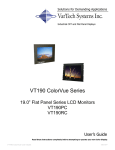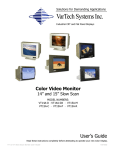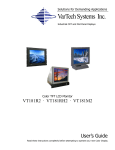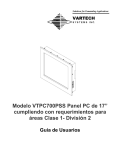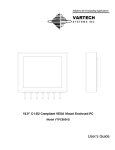Download VarTech Systems VT150R User`s guide
Transcript
Solutions for Demanding Applications VarTech Systems Inc. Industrial CRT and Flat Panel Displays VT150 ColorVue Series 15.0” Flat Panels VT150CC · VT150PC VT150RC · VT150WC · VT150MC User’s Guide Read these instructions completely before attempting to operate your new Color Display. VT150 ColorVue Series User Guide 150-032 Table Of Contents Page Section 1 Warnings and Cautions Section 7 1 Section 2 FCC Statement Page The Display Controls 9 7.1 Display Controls 9 7.2 Screen Adjustment Operation Procedure 9 2 Section 8 Section 3 Product Safety Precautions The Screen Adjustment 3 Section 4 8.1 Main Menu 10 10-11 8.2 OSD Adjusting and Controls 12 8.3 How to use AUTO CONFIG Adjustment 13 Hardware Installation 4 4.1 Unpacking 4 Section 9 4.2 Installation 4 Troubleshooting Tips 4.3 Video Input Pin Assignment 5 14 Section 10 Section 5 Cleaning & Maintenance 15 Touch screen 6 5.1 Touch Screen Introduction 6 Section 11 5.2 Touch Screen Definition 6 Mechanical Drawings 16 Panel Mount Mechanical Drawing 17 Rack Mount Mechanical Drawing 18 Section 6 The Display Timing 7 Wall Mount Mechanical Drawing 19 Table 6.1 VESA Modes 7 Chassis Mount Mechanical Drawing 20 Table 6.2 IBM Modes 8 Table 6.3 Mac Modes 8 Section 12 Specifications VT150 ColorVue Series User Guide 21 150-032 Section WARNING AND CAUTIONS 1 RISK OF ELECTRIC SHOCK! DO NOT OPEN!!! WARRANTY VOID IF CASING IS REMOVED. CAUTION: To reduce the risk of electric shock, do not remove cover (or back). No user serviceable parts inside. Refer servicing to qualified technician. WARNING TO PREVENT FIRE OR SHOCK HAZARD, DO NOT EXPOSE THIS MONITOR TO RAIN OR MOISTURE. “HIGH VOLTAGE EXISTS ON THE BACKLIGHT POWER LEAD OF THIS MONITOR. BEFORE SERVICING, DETERMINE THE PRESENCE OF HIGH VOLTAGE BY CONNECTING THE H.V. METER BETWEEN THE BACKLIGHT POWER LEAD AND CHASSIS ONLY.” CAUTION 1. Keep monitor away from excessive dust, high temperature, moisture or direct sunlight. 2. Use in well ventilated area and do not cover ventilation openings. 3. Unauthorized modifications of this equipment or substitution or attachment of not shielded connecting cable may cause excessive interference. 4. When the monitor is not in use for a long time, turn off power switch. 1 VT150 ColorVue Series User Guide 150-032 Section FCC STATEMENT 2 Federal Communications Commission (F.C.C.) Statement This equipment has been tested and found to comply with the limits for a Class A digital device, pursuant to Part 15 of the FCC Rules. These limits are designed to provide reasonable protection against harmful interference in a industrial installation. This equipment generates, uses and can radiate radio frequency energy and, if not installed and used in accordance with the instructions, may cause harmful interference to radio communications. However, there is no guarantee that interference will not occur in a particular installation. If this equipment does cause harmful interference to radio or television reception, which can be determined by turning the equipment off and on, the user is encouraged to try to correct the interference by one or more of the following measures: • • • • Reorient/Relocate the receiving antenna. Increase the separation between the equipment and receiver. Connect the equipment into an outlet on a circuit different from that to which the receiver is connected. Consult the dealer or an experienced radio or TV technician for help. CAUTION: Changes or modifications not expressly approved by the manufacturer responsible for compliance could void the user's authority to operate the equipment. DOC Compliance Notice This digital apparatus does not exceed the Class A limits for radio noise emissions from digital apparatus set out in the Radio Interference Regulations of the Canadian Department of Communications. 2 VT150 ColorVue Series User Guide 150-032 Section SAFETY PRECAUTIONS 3 Product Safety Precautions ⇒ Ensure that sufficient space is available around the display to provide the circulation necessary for cooling. ⇒ Ensure that the ambient air temperature will not exceed the specified maximum temperature. ⇒ Do not attempt to service this display yourself. The rear chassis has a seal so that non qualified personal will not expose themselves to dangerous voltages or other risks. ⇒ To protect from electrical shock, unplug the display power supply from the wall before moving. ⇒ Do not expose the display to direct sunlight or heat. ⇒ Do not use this display near water ⇒ Do not place any heavy objects on the power cords. Damage may cause electrical shock. ⇒ Unplug the power supply from the wall or unit if one of the following conditions exists. ⇒ Power cord or plug is damaged or frayed ⇒ Liquid is spilled into the display or the display is exposed to rain or water. ⇒ The display does not operate normally when the operating instructions are followed. ⇒ The display has been dropped or the enclosure has been damaged. ⇒ The display exhibits a distinct change in performance, indicating a need for service. 3 VT150 ColorVue Series User Guide 150-032 Section INSTALLATION 4 4.1 Unpacking and setting up your display Your LCD monitor package will consist of the components listed below. Open shipping container and lay all components on a flat clean surface. ⇒ VT150CC, VT150RC, VT150PC, VT150MC or VT150WC LCD Monitor ⇒ 15-PIN D-sub Video cable ⇒ AC power cord ⇒ User Manual or CD ROM 4.2 Installation This analog LCD display DOES NOT require any special drivers. Necessary drivers are supplied by the video card manufacturer and may be found on the diskettes supplied with the video card that came with your computer. Windows 95/98 drivers for both the display and the video card are supplied on the Windows 95/98 CD or diskettes. Unfortunately, Microsoft did not provide a complete listing of the displays on the initial retail release. You may use the standard XGA (1024 x 768 @ 60) as the display type. The video card must also be set up correctly in Windows 95/98 and make sure the video output of the VGA card is on list in Section 5.1 or check your Video Card manual or Windows 95/98 Read me file for further information on Video Card. After the question listed above is solved, we continue the setup procedure as below. 1. 2. 3. 4. Turn power off both Computer and Display before making any connection. Install Display on the solid horizontal surface such as a table or desk. Connect the power cable to the back of the LCD monitor. Connect the signal cable on the rear of the monitor to the 15-pin connector on the rear of the computer and tighten the screws. IBM PC’s & Compatibles Connect one end of the signal cable to the 15-pin connector on the rear of the computer. Apple/Macintosh Connect a MAC adapter to the video connector on the rear of the Apple/Macintosh computer. Then plug the other end of the signal cable into the MAC adapter. (Contact your local Apple dealer for information on purchasing the correct conversion connector.) 5. Tighten the screw of the Display cable until the connectors are fastened securely. 6. Switch on power to the Display, then to the monitor. 4 VT150 ColorVue Series User Guide 150-032 4.3 Video Input Pin Assignment This section describes the pin assignment of the LCD’s video connector. HD15 Video Connector The following table provides the pin numbers and corresponding pin assignments for the HD-15 video connector. Note: The following figure is the view looking into the solder terminal end of the female connector. 1 15 Pin assignments for the HD15 video connector Pin Connection 1 Red Video 2 Green Video 3 Blue Video 4 No Connection 5 Ground 6 Red Video Ground 7 Green Video Ground 8 Blue Video Ground 9 No Connection 10 Ground 11 No Connection 12 DDC data 13 Horizontal Sync 14 Vertical Sync 15 DDC Clock 5 VT150 ColorVue Series User Guide 150-032 Section 5 5.1 TOUCH SCREEN Introduction Touch screens are a common means to interface operator inputs to a system. The universal standard of Windows GUI (Graphical User Interface) has significantly increased the use of touch screens. There are four main touch technologies. The technologies are resistive, surface acoustic wave (SAW), capacitive, and infrared (IR). Each touch technology has advantages and disadvantages based on different user applications. 5.2 Installation All Vartech Systems displays configured with a touch screen are supplied with a CDROM which includes user manuals, application software, and drivers for various operating systems. Insert the supplied CDROM into a CDROM drive and follow the installation instructions that will appear on the screen. Limited technical support is available by contacting Vartech Systems customer support at 800-223-8050. 6 VT150 ColorVue Series User Guide 150-032 Section DISPLAY TIMING 6 The following table lists the better display quality modes that the LCD monitor provides. If the other video modes are input, the monitor will stop working or display unsatisfactory picture quality. VESA MODES Horizontal Nominal Frequency ±0.5KHz Vertical Nominal Frequency ±1Hz Nominal Pixel Clock (MHz) Mode Resolution Total DOS 720 x 400@70Hz 900 x 449 31.469 70.087 28.322 640 x 480@60Hz 800 x 525 31.469 59.940 25.175 640 x 480@72Hz 832 x 520 37.861 72.809 31.500 640 x 480@75Hz 840 x 500 37.500 75.000 31.500 800 x 600@56Hz 1024 x 625 35.156 56.250 36.000 800 x 600@60Hz 1056 x 628 37.879 60.017 40.000 800 x 600@72Hz 1040 x 666 48.077 72.188 50.000 800 x 600@75Hz 1056 x 625 46.875 75.000 49.500 1024 x 768@60Hz 1344 x 804 48.363 60.004 65.000 1024 x 768@70Hz 1328 x 806 56.476 70.069 75.000 1024 x 768@75Hz 1312 x 800 60.023 75.029 78.750 VGA SVGA XGA Table 6.1 Applicable video timing - VESA Modes 7 VT150 ColorVue Series User Guide 150-032 Display Timing Cont. IBM MODES Horizontal Nominal Frequency ±0.5KHz Vertical Nominal Frequency ±1Hz Nominal Pixel Clock (MHz) Mode Resolution Total EGA 640 x 350@70Hz 800 x 449 31.469 70.086 25.175 CGA 640 x 480@60Hz 800 x 449 31.469 70.086 25.175 DOS 800 x 600@56Hz 900 x 449 31.469 70.087 28.322 VGA 800 x 600@60Hz 800 x 525 31.469 59.940 25.275 XGA 800 x 600@72Hz 1304 x 798 57.515 72.100 75.000 Table 6.2 Applicable video timing - IBM Modes MAC MODES Mode VGA SVGA XGA Horizontal Nominal Frequency ±0.5KHz Vertical Nominal Frequency ±1Hz Nominal Pixel Clock (MHz) Resolution Total 640 x 480@60Hz 800 x 525 31.469 59.940 25.175 640 x 480@67Hz 864 x 525 35.000 66.667 30.240 832 x 624@75Hz 1152 x 667 49.725 74.551 57.283 1024 x 768@60Hz 1312 x 813 48.780 60.001 64.000 1024 x 768@75Hz 1328 x 804 60.241 74.927 80.000 Table 6.3 Applicable video timing - MAC Modes 8 VT150 ColorVue Series User Guide 150-032 Section DISPLAY CONTROLS 7 7.1 Display Controls Button Description Power (Located on the rear of the monitor) MENU SEL Function Press the power key to turn the monitor on. Press it again to turn the monitor off MENU Enter or exit the OSD adjustment menu. Exit from the submenu back to the previous menu. SELECT To confirm the current selection. ADJUST UP To scroll up in menu or to increase value of selected item. ADJUST DOWN To scroll down in menu or to decrease value of selected item. 7.2 Screen Adjustment Operation Procedure 1. Entering the screen adjustment The setting switches are normally at stand-by. Push the MENU button once to display the main menu of the screen adjustment. The adjustable items will be displayed in the main menu. 2. Entering the settings Use the Adjust and Adjust buttons to select the desired setting icon and push the SELECT button to enter sub-menu. 3. Change the settings After the sub-menu appears, use the Adjust values. and Adjust buttons to change the setting 4. Save After finishing the adjustment, push the SELECT button to memorize the setting. 5. Return & Exit the main menu Exit the screen adjustment, push the ‘SELECT; button at the ‘EXIT; of “MISC MENU”. When no operation is done around 60 sec (default OSD timeout), it goes back to the stand-by mode and no more switching is accepted except MENU to restart the setting. 9 VT150 ColorVue Series User Guide 150-032 Section SCREEN ADJUSTMENT 8 8.1 Main Menu The OSD main menu (Figure 8-1) is displayed on screen when the MENU key pressed. The OSD menu is a combination of graphic and text display. The column inside the OSD menu will show information of input image. Second column beneath OSD menu shows the item selected. The UP and DOWN keys are used to scroll through items within the menu. The selected item is highlighted as the scrolling move along. The SELECT key is used to activated the highlighted item during this state. YES NO Figure 8.1 - OSD Main Menu 10 VT150 ColorVue Series User Guide 150-032 8.2 OSD Adjusting and Controls OSD Functions Symbol description Function Auto Config is used to adjust the configuration of the phase · clock · vertical and horizontal position automatically. A confirmation box is displayed to confirm the user selection. The default selection in the box is “NO” and is highlighted by a red bar. If the SELECT key is pressed, the main menu is re-displayed and nothing is changed. When “YES” is selected, AUTO CONFIG automatic configuration is started. After the process is completed successfully, a confirmation box, “Does this image look correct”, is displayed. If image is correct, select “YES” to exit confirmation box. If image isn’t correct, select “NO” to PHASE item adjustment, and adjust the phase manually to the best image quality. BRIGHTNESS Brightness is used to setup the brightness of the panel. CONTRAST Contrast is used to adjust image contrast. COLOR The main menu item “COLOR” is a sub-menu which contains items to adjust the PC graphic imaging. RED Red is used to adjust the gain of the red channel in ADC. GREEN Green is used to adjust the gain of the green channel in ADC. BLUE Blue is used to adjust the gain of the blue channel in ADC. BLACK LEVEL ADJUST Black level adjust is used to adjust the black-level (zero level offset) of the AD converters. 11 VT150 ColorVue Series User Guide 150-032 OSD Functions Symbol description Function POSITION Setup the image position within the panel. There are two items: H-POSITION · V-POSITION. H-POSITION H-Position is used to adjust the horizontal image position manually. A slider with current value is displayed. V-POSITION V-Position is used to adjust the vertical image position manually. A slider with current value is displayed. IMAGE Configure the image frequency. PHASE Phase is used to adjust the ADC sample pixel clock. A slider with the current value is displayed. The range of phase adjustment value is 0 to 100 for 0 to 360 degrees. CLOCK Clock is used to adjust the number of clocks (pixels) per line (sample per line). A slider with current value is displayed. MISC MENU Miscellaneous setting. There are three items: RESET · OSD POSITION · SYSTEM INFO. RESET Reset is used to reload all factory default parameters. OSD POSITION OSD Position is used to setup the OSD menu position. The OSD menu horizontal and vertical position is adjusted separately. Each position adjustment item will bring up the slider window. The maximum value of the sliders are based on the size of the OSD menu. SYSTEM INFO The system info menu provides the user with detailed information regarding the current input format and version. (VERSION · V-FREQ · H-FREQ · RESOL). Note: If you don’t press any key for 45 seconds, the OSD will disappear by itself and the parameters will not be saved. 12 VT150 ColorVue Series User Guide 150-032 8.3 How to use AUTO CONFIG Adjustment This function can tune the parameters of PHASE · CLOCK · H-POSITION and V-POSITION. Suggesting Adjustment Steps: Step 1: Enter the Windows 95/98 Shut-down frame. (Note the Wallpaper color CAN NOT be black.) Step 2: Enter OSD Main Menu and choose “AUTO CONFIG”, then press SELECT key. The picture will auto-adjust by itself. After 4 seconds, you can exit OSD and Shut-down frame. Step3: If you are still not satisfied with the picture quality, you can choose CONTRAST item in OSD Main Menu and adjust it. NOTE: 1. If you don’t like the effect of AUTO CONFIG adjustment, you can adjust PHASE, CLOCK, H-POSITION and V-POSITION in OSD. 2. AUTO CONFIG adjustment can be used in Windows 95/98 except black background frame, but the best effect is in the SHUT DOWN frame. 3. It is recommended to run “EDIT” program first, then do AUTO CONFIG adjustment in DOS mode. 13 VT150 ColorVue Series User Guide 150-032 Section TROUBLESHOOTING 9 Troubleshooting Tips Problem Troubleshooting Tip No image on display screen 1. Check that power cord of the computer has been connected securely into wall outlet or grounded extension cable or strip. 2. Check that power switch of the Display has been pressed. 3. Check that Video (Signal) Cable from the Display has been securely and correctly connected. 4. Check that Video Card is firmly seated in card slot of Computer motherboard. 5. Check that the video input from the Video Card falls within the timing range (listed in the table of section 6) of the Display. Abnormal image 1. Check that the video input from the Video Card falls within the timing range (listed in the table of section 6) of the Display. 2. Check that Video (Signal) Cable from the Display has been securely and correctly connected to the Video Connector at the rear side of the Computer. Colors of image on screen are abnormal 1. Check that Video (Signal) Cable from the displays has been securely and correctly connected to the 15-pin Video Connector at the rear side of the computer. Disturbances on Screen 1. OSD adjustment is incorrect. Please consult section 8 for OSD screen adjustment procedures. 14 VT150 ColorVue Series User Guide 150-032 Section 10 CLEANING AND MAINTENANCE Cleaning Occasionally clean the display panel and cabinet with a soft cloth dampened (not soaked) with a mild (non-abrasive) glass cleaner. Keep turning a fresh side of the cloth toward the screen surface to avoid scratching it with accumulated grit. Note: The solvent should be applied only to the cloth, and not directly on the monitor screen. Do not use paper products as they may scratch the surface. To minimize the risk of abrasion, allow the screen to stand dry. Special care should be taken when cleaning a touch screen or polycarbonate shield that is installed over the screen. Abrasive and certain chemical cleaners can easily damage the surface. Never use alcoholic or ammoniac cleaners to clean the polycarbonate shield or a touch screen. Replacing a Line Cord To avoid shock and fire hazards, the monitor’s power cord should be replaced if the insulation becomes broken or if it develops a loose internal connection. Other Maintenance Qualified service personnel should perform all maintenance, except for the power cord replacement described above. 15 VT150 ColorVue Series User Guide 150-032 Section MECHANICAL DRAWINGS 11 Mechanical Drawings Model Description Page(s) VT150PC 15.0” ColorVue Panel Mount Mechanical Drawing 17 VT150RC 15.0” ColorVue Rack Mount Mechanical Drawing 18 VT150WC 15.0” ColorVue Wall Mount Mechanical Drawing 19 VT150CC 15.0” ColorVue Chassis Mount Mechanical Drawing 20 16 VT150 ColorVue Series User Guide 150-032 Section SPECIFICATIONS 12 VT150 ColorVue Specifications LCD panel type 15.0” TFT Resolution XGA 1024 x 768 Max. Pixel dimension 0.297mm LCD display color 16.7M Colors max. OSD control H/V Position, Clock, Phase, Auto Config, Expand, Information, Recall, Edge Filter, Color, OSD Adjust, Contrast, Brightness, Exit Manual Control Menu, Select, Adjust ( Viewing angle Left / Right: 60/60º max. Up / Down: 40/60º max. Contrast ratio 300:1 typ. Brightness 250cd/m² Typ. Response time TR: 10ms typ. TF: 10ms typ. ) Power Active display area: VT150WC / T150MC 12.11” x 9.12” / 304.1mm x 228.1mm VT150PC / VT150RC / VT150CC 12.03” x 9.09” / 305.5mm x 230.8mm AC Input AC 100/240V, 50/60Hz Input connector HD15 Input signal Video: Analog 0.7V p-p 75Ω Sync; TTL Level, Positive/Negative, Separate Sync Scan Frequency Horizontal: 31 to 60kHz Vertical: 56 to 75Hz Power Consumption 30 Watts Maximum Power management VESA DPMS Compatible Regulation Safety: DHHS, FCC A Temperature Operation: 0 to 50ºC Storage: -20 to 60ºC Plug & Play DDC 2B 21 VT150 ColorVue Series User Guide 150-032 VARTECH SYSTEMS INC. HEADQUARTERS 11529 Sun Belt Ct. Baton Rouge, Louisiana 70809 Toll-Free: 800.223.8050 International Phone: 001.225.298.0300 Fax: 225.297.2440 E-mail: [email protected] www.vartechsystems.com 150-032-007 09.10.04 VT150 ColorVue Series User Guide 150-032




















